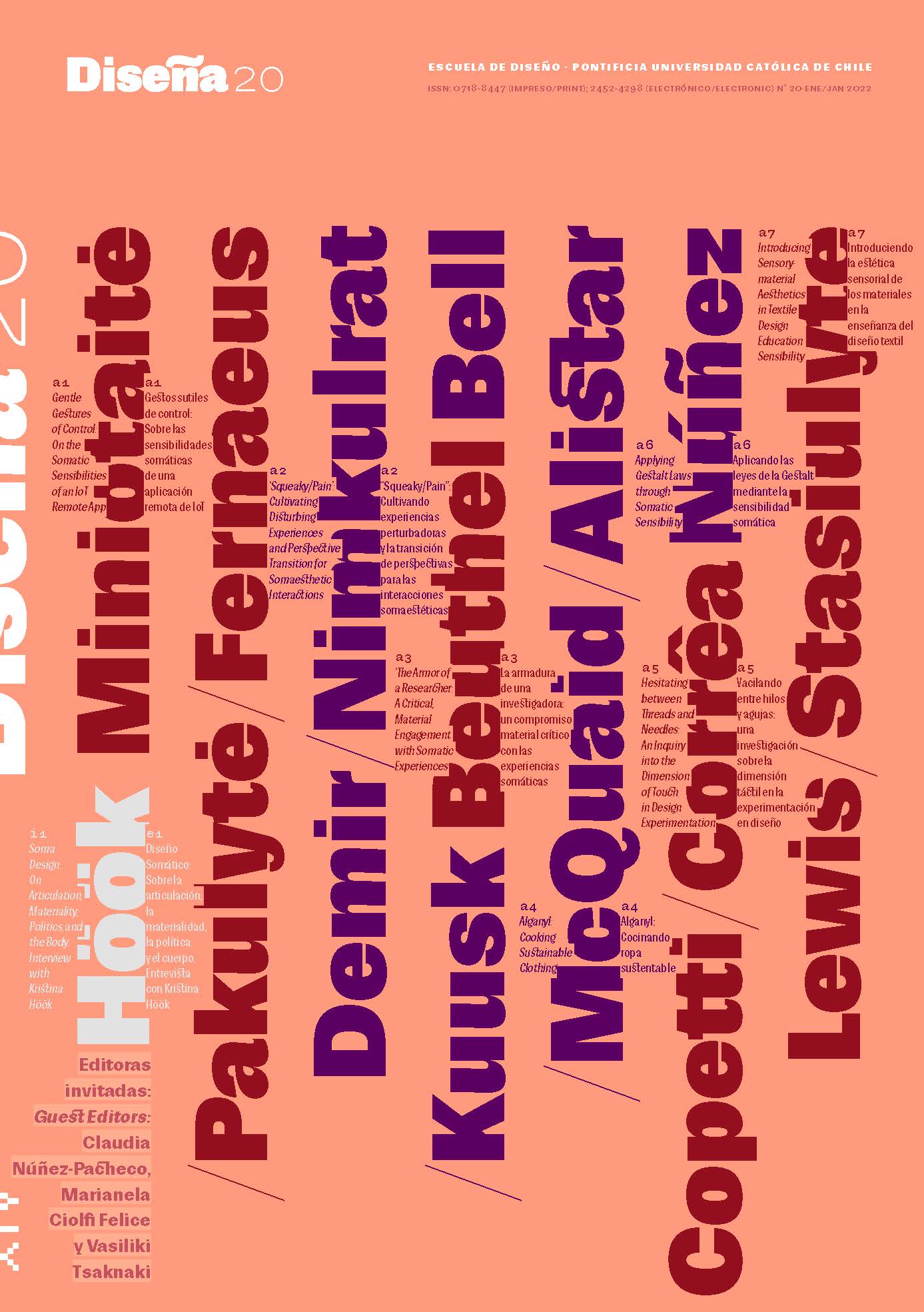Hesitating between Threads and Needles: An Inquiry into the Dimension of Touch in Design Experimentation
Main Article Content
Abstract
Even though experimentation and its material aspect are linked to the practice of design, few texts approach the concept intertwined with a dimension of touch. Considering the uncertain and critical times in which we perceive ourselves as a society, we need practices different from those prevalent in interaction design fields, yet capable of touching other possible worlds. We trust that the act of slowing down enables us to cultivate a distinct sensitivity, hesitating in the construction of a ‘good common world’. This article investigates spaces of hesitation through touch-oriented experimentation and reports on one case of an experimental practice developed from the formation of an embroidery collective. The practice proposes a design performance more engaged with uncertainties, care, and subjectivities.
Downloads
Article Details

This work is licensed under a Creative Commons Attribution-ShareAlike 4.0 International License.

This work is licensed under a Creative Commons Attribution-ShareAlike 4.0 International license.
COPYRIGHT NOTICE
All contents of this electronic edition are distributed under the Creative Commons license of "Attribution-ShareAlike 4.0 Internacional" (CC-BY-SA). Any total or partial reproduction of the material must mention its origin.
The rights of the published images belong to their authors, who grant to Diseña the license for its use. The management of the permits and the authorization of the publication of the images (or of any material) that contains copyright and its consequent rights of reproduction in this publication is the sole responsibility of the authors of the articles.
References
Bentz, I. (2014). Processo de projeto: Do ponto de vista aos efeitos de sentidos. 11 Congresso Brasileiro de Pesquisa e Desenvolvimento Em Design, Blucher Design Proceedings, 1(4), 570–579. http://dx.doi.org/10.5151/designpro-ped-01254
Binder, T., Brandt, E., Ehn, P., & Halse, J. (2015). Democratic Design Experiments: Between Parliament and Laboratory. CoDesign, 11(3–4), 152–165. https://doi.org/10.1080/15710882.2015.1081248
Brandt, E., Eriksen, M. A., Binder, T., & Redström, J. (2015). The Perform Codesign Experiment – On What People Actually Do and the Relation Between Program and Experiment in Research Through Design. IASDR 2015 Interplay: Proceedings Publication, 234–249. http://iasdr2015.com/wp-content/uploads/2015/11/IASDR_Proceedings_Final.pdf
Chen, X., Shao, F., Barnes, C., Childs, T., & Henson, B. (2009). Exploring Relationships between Touch Perception and Surface Physical Properties. International Journal of Design, 3(2), 67–76.
de Assis, P. (2015). Introduction. In P. de Assis (Ed.), Experimental Affinities in Music (pp. 7–14). Leuven University Press.
Diergarten, F. (2015). Omnis ars ex experimentis dependeat: “Experiments” in Fourteenth-Century Musical Thought. In P. de Assis (Ed.), Experimental Affinities in Music (pp. 42–63). Leuven University Press.
DiSalvo, C. (2014). Critical Making as Materializing the Politics of Design. The Information Society, 30(2), 96–105. https://doi.org/10.1080/01972243.2014.875770
Goehr, L. (2015). Explosive Experiments and the Fragility of the Experimental. In P. de Assis (Ed.), Experimental Affinities in Music (pp. 15–41). Leuven University Press.
Haraway, D. J. (1995). Saberes localizados: A questão da ciência para o feminismo e o privilégio da perspectiva parcial. Cadernos Pagu, 5, 7–41.
Haraway, D. J. (2008). When Species Meet. University of Minnesota Press.
Höök, K. (2018). Designing with the Body: Somaesthetic Interaction Design. MIT Press.
Höök, K., Ståhl, A., Jonsson, M., Mercurio, J., Karlsson, A., & Johnson, E.-C. B. (2015). Somaesthetic Design. Interactions, 22(4), 26–33. https://doi.org/10.1145/2770888
Ingold, T. (2012). Trazendo as coisas de volta à vida: Emaranhados criativos num mundo de materiais. Horizontes Antropológicos, 18(37), 25–44. https://doi.org/10.1590/S0104-71832012000100002
Ingold, T. (2013a). Being Alive: Essays on Movement, Knowledge and Description. Routledge.
Ingold, T. (2013b). Making: Anthropology, Archaeology, Art and Architecture. Routledge.
Ingold, T. (2021). Correspondences. Polity.
Le Guin, U. K. (2019). The Carrier Bag Theory of Fiction. Ignota Books.
Lindström, K., & Ståhl, Å. (2017). Politics of Inviting: Co-Articulations of Issues in Designerly Public Engagement. Diseña, (11), 110–121. https://doi.org/10.7764/disena.11.110-121
Meyer, G. E. C. (2018). A experimentação como espaço ambivalente de antecipação e proposição de controvérsias. Estudos em Design, 26(1), 29–47.
Meyer, G. E. C. (2019). Strategic Design, Cosmopolitics and Obscure Situations. Strategic Design Research Journal, 12(3), 417–432.
Pallasmaa, J. (2009). Os olhos da pele: A arquitetura e os sentidos. Artmed.
Patarroyo, J., Cortés-Rico, L., Sánchez-Aldana, E., Pérez-Bustos, T., & Rincón, N. (2019). Testimonial Digital Textiles: Material metaphors to think with care about reconciliation with four memory sewing circles in Colombia. Proceedings of the 8th Bi-Annual Nordic Design Research Society Conference - Who Cares?, Article 8.
Pérez-Bustos, T., Tobar-Roa, V., & Márquez-Gutiérrez, S. (2016). Etnografías de los contactos. Reflexiones feministas sobre el bordado como conocimiento. Antípoda. Revista de Antropología y Arqueología, 26. https://doi.org/10.7440/antipoda26.2016.02
Puig de la Bellacasa, M. (2017). Matters of Care: Speculative Ethics in More than Human Worlds. University of Minnesota Press.
Pye, D. (1968). The Nature and Art of Workmanship. Cambridge University Press.
Ratto, M. (2011). Critical Making: Conceptual and Material Studies in Technology and Social Life. The Information Society, 27(4), 252–260. https://doi.org/10.1080/01972243.2011.583819
Rose, H. (1983). Hand, Brain, and Heart: A Feminist Epistemology for the Natural Sciences. Signs: Journal of Women in Culture and Society, 9(1), 73–90. https://doi.org/10.1086/494025
Shercliff, E., & Twigger Holroyd, A. (2016). Making With Others: Working with textile craft groups as a means of research. Studies in Material Thinking, 14, Article 07.
Stengers, I. (2018). A proposição cosmopolítica. Revista do Instituto de Estudos Brasileiros, 69, 442–464. https://doi.org/10.11606/issn.2316-901X.v0i69p442-464
Tsing, A. L. (2015). The Mushroom at the End of the World: On the Possibility of Life in Capitalist Ruins. Princeton University Press.

